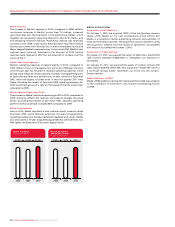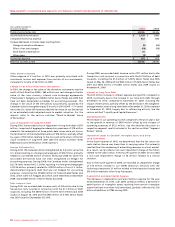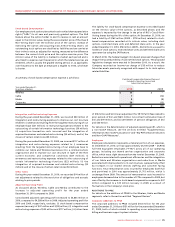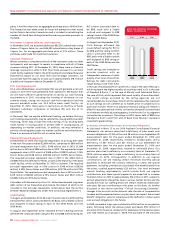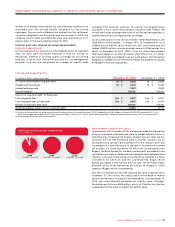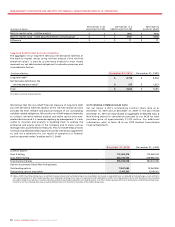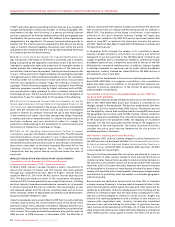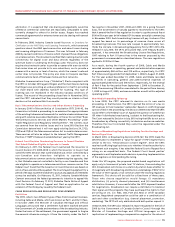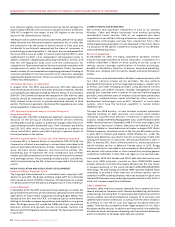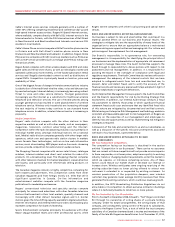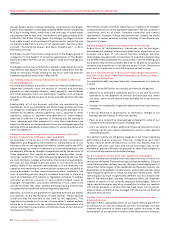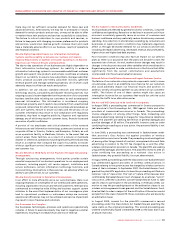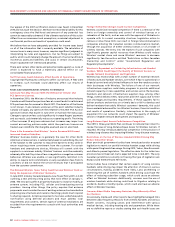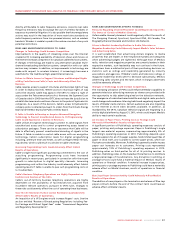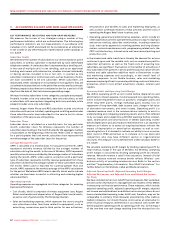Rogers 2010 Annual Report Download - page 48
Download and view the complete annual report
Please find page 48 of the 2010 Rogers annual report below. You can navigate through the pages in the report by either clicking on the pages listed below, or by using the keyword search tool below to find specific information within the annual report.
MANAGEMENT’S DISCUSSION AND ANALYSIS OF FINANCIAL CONDITION AND RESULTS OF OPERATIONS
52 ROGERS COMMUNICATIONS INC. 2010 ANNUAL REPORT
(In millions of dollars) Less Than 1 Year 1–3 Years 4–5 Years After 5 Years Total
Long-term debt(1) $ – $ 1,164 $ 1,920 $ 5,639 $ 8,723
Derivative instruments(2) – 406 418 60 884
Operating leases 130 158 73 43 404
Player contracts 53 34 19 9 115
Purchase obligations(3) 572 532 338 240 1,682
Pension obligation(4) 70 – – – 70
Other long-term liabilities – 65 20 39 124
Total $ 825 $ 2,359 $ 2,788 $ 6,030 $ 12,002
Computershare Trust Company of Canada is the Plan Agent and acts on
behalf of participants to invest eligible dividends. Registered
shareholders of Rogers wishing to participate in the DRIP can find the
full text of the DRIP Plan Document and enrolment forms at
computershare.com/rogers. Non-registered beneficial shareholders are
advised to contact their broker, investment dealer or other financial
intermediary for details on how to participate in the DRIP.
While Rogers, at its discretion, may fund the quarterly DRIP share
requirements with either Class B Non-Voting shares acquired on the
Canadian open market or issued by Rogers, our current intention is that
such shares will, for the foreseeable future, be acquired on the
Canadian open market by the DRIP Agent.
Material Obligations Under Firm Contractual Arrangements
(1) Amounts reflect principal obligations due at maturity.
(2) Amounts reflect net disbursements due at maturity.
(3) Purchase obligations consist of agreements to purchase goods and services that are enforceable and legally binding and that specify all significant terms, including fixed or minimum quantities to be
purchased, price provisions and timing of the transaction. In addition, we incur expenditures for other items that are volume-dependent.
(4) Represents expected contributions to our pension plans in 2011. Contributions for the year ended December 31, 2012 and beyond cannot be reasonably estimated as they will depend on future economic
conditions and may be impacted by future government legislation.
Quarterly dividends are only payable as and when declared by Rogers’
Board of Directors and there is no entitlement to any dividend prior
thereto. Before enrolling, shareholders are advised to read the
complete text of the DRIP and to consult their financial advisors
regarding their unique investment profile and tax situation. Only
Canadian and U.S. residents can participate in the DRIP.
COMMITMENTS AND OTHER CONTRACTUAL OBLIGATIONS
Contractual Obligations
Our material obligations under firm contractual arrangements are
summarized below at December 31, 2010. See also Notes 14, 15 and 23
to the 2010 Audited Consolidated Financial Statements.
OFF-BALANCE SHEET ARRANGEMENTS
Guarantees
As a regular part of our business, we enter into agreements that
provide for indemnification and guarantees to counterparties in
transactions involving business sale and business combination
agreements, sales of services and purchases and development of assets.
Due to the nature of these indemnifications, we are unable to make a
reasonable estimate of the maximum potential amount we could be
required to pay counterparties. Historically, we have not made any
significant payment under these indemnifications or guarantees. Refer
to Note 15(e)(ii) to the 2010 Audited Consolidated Financial Statements.
Derivative Instruments
As previously discussed, we use derivative instruments to manage our
exposure to interest rate and foreign currency risks. We do not use
derivative instruments for speculative purposes.
Operating Leases
We have entered into operating leases for the rental of premises,
distribution facilities, equipment and microwave towers and other
contracts. The effect of terminating any one lease agreement would
not have an adverse effect on us as a whole. Refer to the section
entitled “Contractual Obligations” above and Note 23 to the 2010
Audited Consolidated Financial Statements.
4. OPERATING ENVIRONMENT
Additional discussion of regulatory matters and recent developments
specific to the Wireless, Cable and Media segments follows.
GOVERNMENT REGULATION AND REGULATORY DEVELOPMENTS
Substantially all of our business activities, except for Cable’s Rogers
Retail segment and the non-broadcasting operations of Media, are
subject to regulation by one or more of: the Canadian Federal
Department of Industry, on behalf of the Minister of Industry (Canada)
(collectively, “Industry Canada”), the CRTC under the
Telecommunications Act (Canada) (the “Telecommunications Act”) and
the CRTC under the Broadcasting Act (Canada) (the “Broadcasting Act”),
and, accordingly, our results of operations are affected by changes in
regulations and by the decisions of these regulators.
Canadian Radio-television and Telecommunications Commission
Canadian broadcasting operations, including our cable television
systems, radio and television stations, and specialty services are licenced
(or operated pursuant to an exemption order) and regulated by the
CRTC pursuant to the Broadcasting Act. Under the Broadcasting Act,
the CRTC is responsible for regulating and supervising all aspects of the
Canadian broadcasting system with a view to implementing certain
broadcasting policy objectives enunciated in that Act.


